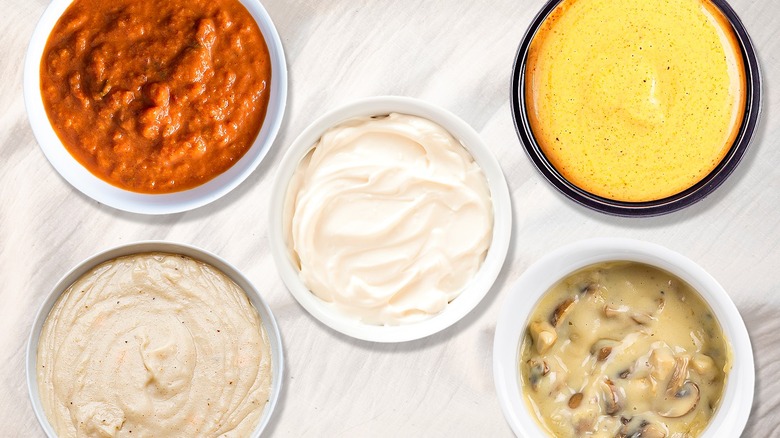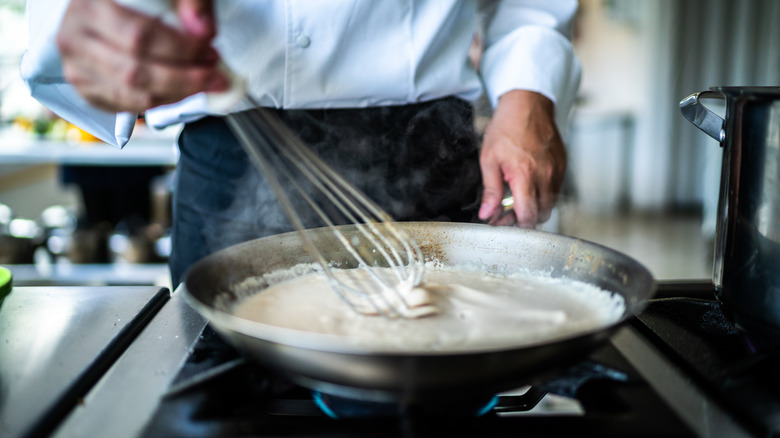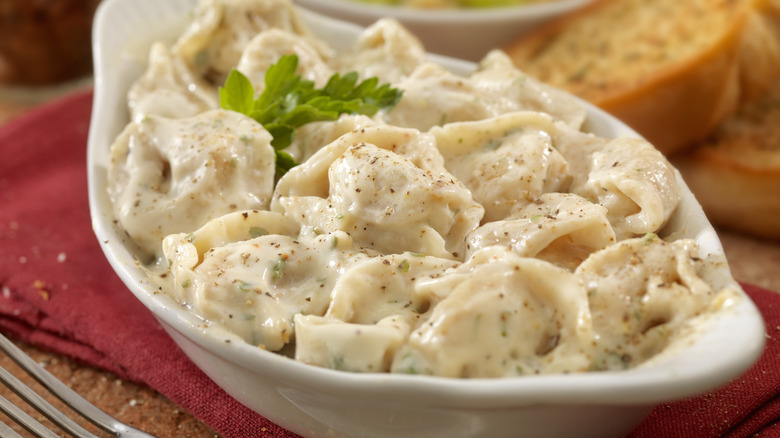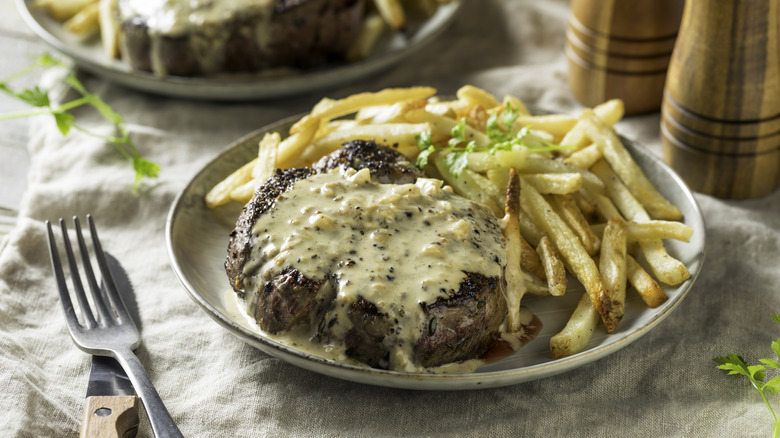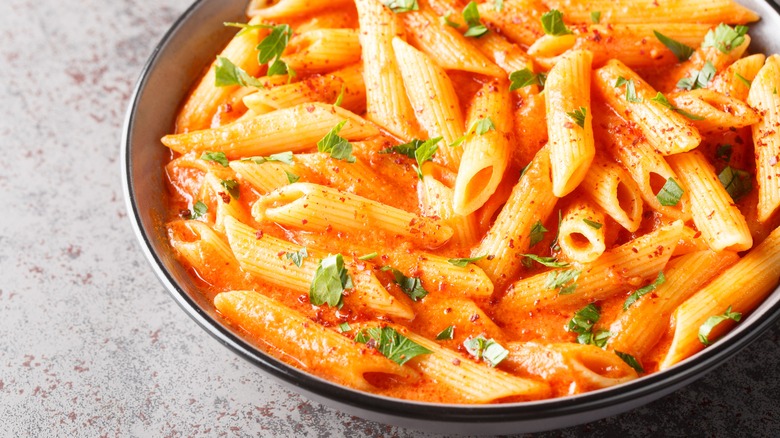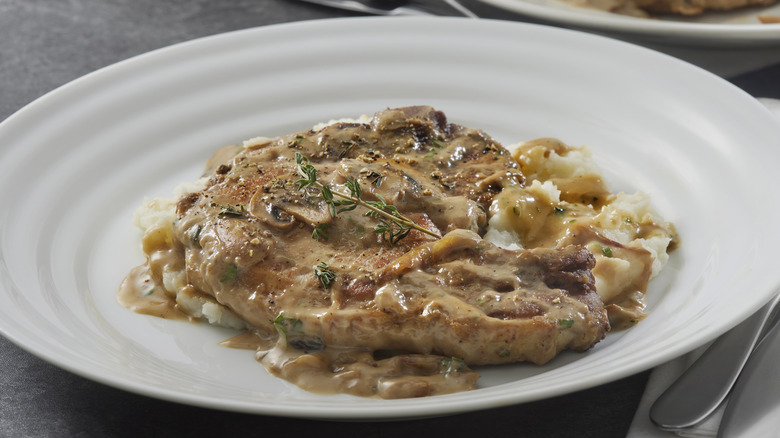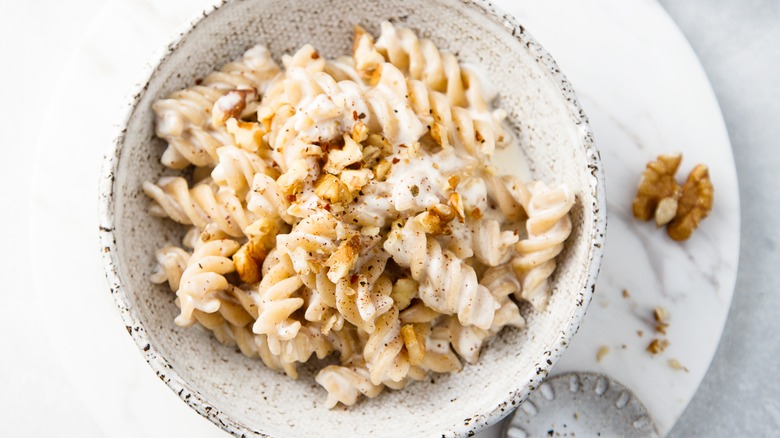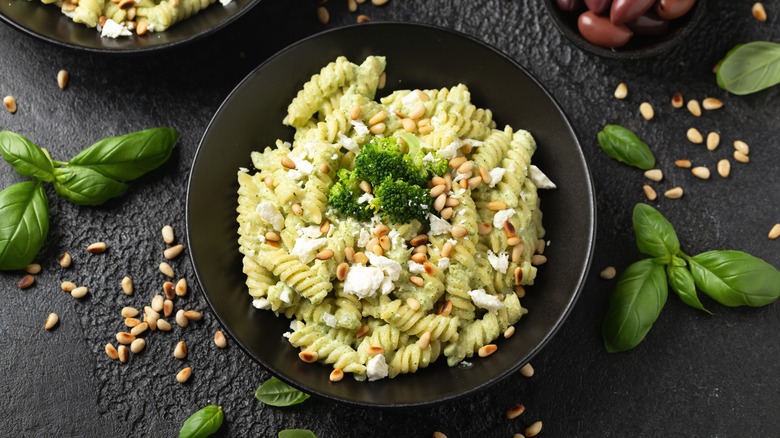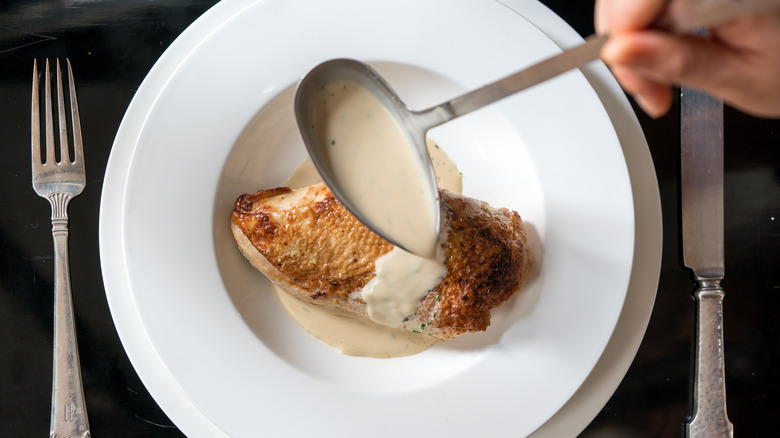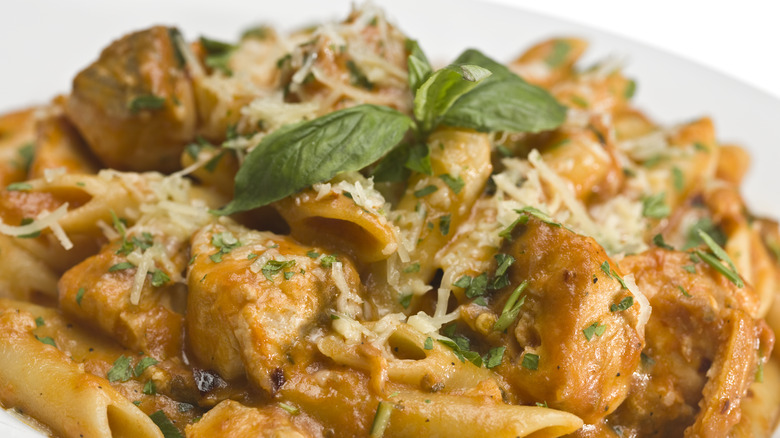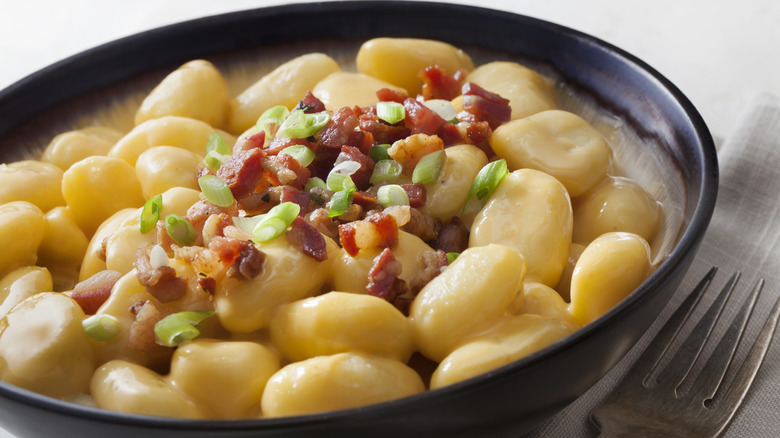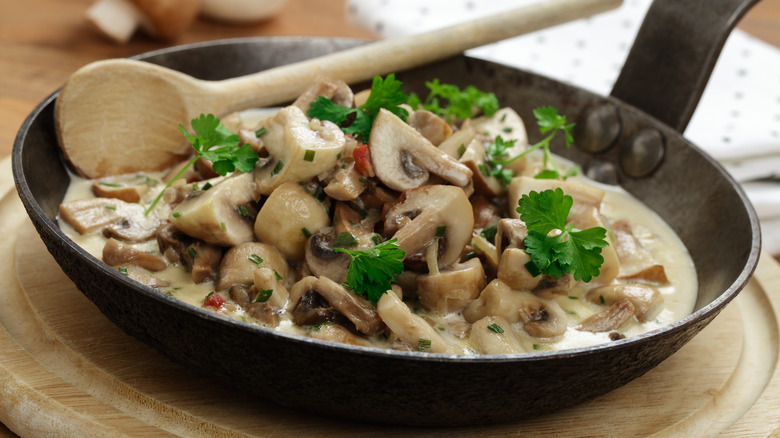12 Cream-Based Sauces You Should Know, According To A Trained Chef
Culinary schools spend a lot of time teaching aspiring chefs about sauces, and with good reason. A sauce can be the detail that salvages a mediocre meal, makes a good one great, or a great one truly transcendent.
Cream sauces hold an interesting position within the sprawling sauce category. They don't fit neatly into the old-school framework of "mother" sauces and their derivatives, because you'll find them in several branches of that structure. Heavy cream brings richness and silkiness to any sauce, which makes it a powerful tool for anyone looking to level up in the kitchen.
As a trained chef and former restaurateur, I've had that formal education in sauce-making, and I've made a lot of cream-based sauces at work and at home. Most of them are easier than you'd think and can make your dishes feel more sophisticated. Here are many tasty and versatile cream sauces that I think you should know.
1. Basic cream sauce
One of the most useful mother sauces is béchamel, a subtly flavored white sauce. It's made of milk and a few aromatic flavoring ingredients, thickened with a flour-based roux. It's a simple sauce to learn and was the first I taught to my kids. It's useful all on its own (it's a great sauce for casseroles, for example), but it can easily be adapted to make other sauces, such as cream sauce.
Upgrading béchamel sauce into cream sauce couldn't be simpler. Start with your favorite béchamel, and replace part of the milk with heavy cream. That's it. The proportions are up to you. Four parts milk to one of cream makes for a slightly rich béchamel. Two or three parts milk to one of cream make for a rich and silky sauce. You can keep going, if you wish: You can use equal parts cream and milk, or even all cream, though you may find the resulting sauce is richer than you'd like.
This basic cream sauce can itself be used as a base to develop other sauces, or thinned to become a cream soup. Its only shortcoming is that, while heavy cream adds richness, it mutes flavors. The more cream your sauce contains, the more you'll need to lean on bold flavors to counter its richness.
2. Alfredo sauce
You'll hear a lot of disagreement among pasta lovers over what does and does not belong in an authentic Alfredo sauce. In truth, there's very little authenticity about it. In its original form, it was just pasta with butter and Parmesan, similar to cacio e pepe in its simplicity. It's not frequently served in Italy, outside of touristy areas, and Italians shake their heads over it. To them, it's as incomprehensible as slapping a catchy name on buttered toast.
That being said, the Americanized version of the dish is a fine and comforting dish in its own right. Rather than relying on an emulsion of butter, cheese, and the pasta's cooking water to form a creamy sauce, Alfredo as it's made on this continent cuts to the chase and uses heavy cream as the base of its sauce.
It's not especially authentic, but "Americanized" Alfredo sauce is a pretty good thing in its own right. You'll start by simmering butter and cream together for a few moments until it thickens slightly, then whisk in some flavorings and a whole lot of finely grated Parmesan. The resulting sauce is rich and cheesy, a perfect pick-me-up on days when you need a bowl full of comfort.
3. Green peppercorn sauce
Some sauces put cream at the forefront, and any other added flavors are there to enhance the cream. Other sauces put the shoe on the other foot: They place a boldly dominant flavor front and center, and it's the heavy cream that plays a supporting role.
The latter is very much the case with green peppercorn sauce. Green peppercorns are harvested from the same plant as black pepper or white pepper, but they're picked earlier while still soft and immature. They're usually pickled or brined, but increasingly available fresh or freeze-dried in some areas. Their most famous use is in green peppercorn sauce, used for a French bistro classic known simply and accurately as "steak au poivre," or peppered steak.
The dominant flavor comes from the green peppercorns, which are brighter and milder than black pepper and have a grassy undertone. Heavy cream, beef broth, and a splash of Cognac provide the supporting flavors, and the cream's richness smooths out any harsh edges in the flavors. Try it with your next steak; if you've never had it before, you'll be impressed.
4. Easy tomato cream sauce
Traditionally, most pasta sauces — in North America, if not necessarily in Italy — could be divided into two broad categories; tomato sauces, and creamy sauces. In recent years, that line has begun to blur, with many popular sauces adding cream to a tomato base.
Some recipes begin with the usual multi-step process of making a tomato sauce, but you don't necessarily need to go there. If you're pressed for time, you can make a perfectly acceptable tomato-cream sauce with just two ingredients: a can of tomato paste, and some heavy cream. Tomato paste straight from the can may have a metallic aftertaste, so you'll get your best flavor by browning and caramelizing it in a splash of oil before adding the cream, which technically, I suppose, constitutes a third ingredient.
Add the cream and stir until the ingredients are thoroughly mixed, and then simmer for a few moments until they begin to thicken. The sauce is fine as-is, with nothing added other than salt and pepper, but you can add any of the usual pasta-friendly flavors that appeal to you (garlic, bacon, rosemary, basil, and so on). If you swap the tomato paste for a can of crushed tomatoes, you'll get a very good quick-and-dirty tomato soup instead of a pasta sauce.
5. Mushroom cream sauce
There are cream sauces, which are made with — what else — cream, and then there are "creamy" sauces which don't always use actual cream. Some, like authentic carbonara, create their creaminess with a mixture of hard cheese and the pasta's cooking water. Others use ready-made ingredients, like canned cream of mushroom soup.
If canned cream soups are one of your culinary staples, that's fine. They're genuinely convenient, and there's no shame in doing what you have to do to put dinner on the table. But if you aren't pressed for time, making your own mushroom cream sauce from scratch is easier than you might think. You can add béchamel to sautéed mushrooms, for example, but it's not necessary to use a starch thickener.
Saute your mushrooms with onions, garlic, and whatever other aromatics you like, and then deglaze the pan with a splash of wine (if you wish) and some broth. As the broth simmers, evaporation will cause it to concentrate and thicken naturally, and then you can finish it off with a few tablespoons of cream. Seriously, try this. It's a night and day difference from the canned stuff, and not at all difficult to cook.
6. Ligurian walnut sauce
In the days before starch-based thickeners became popular, a lot of sauces were nut-based. We all know that nuts can be ground to a thick and creamy consistency (hello, peanut butter!) and their combination of fat, fiber, and oil gives them the ability to do the same for sauces built around them.
Some of those sauces live on in the present day, with pesto being the best-known, but the same region that gave us pesto has another good one up its sleeve. This is Liguria, which is famous for — among other things — its walnuts, and those walnuts provide the base of a remarkable walnut pasta sauce. Its creaminess comes from a combination of nuts pounded in a mortar and pestle, cream-soaked bread, and cheese.
Liguria is in the northern half of Italy, where pasta is usually the fresh homestyle kind rather than the machine-made dry variety, so those are the most appropriate kinds of pasta to serve it with. Think in terms of fresh-made filled pasta, or your homemade fresh pasta.
7. Pesto cream sauce
As big, bold flavors go, basil is right up there. It's heady and aromatic, and usually one of the signature ingredients of summer. Pesto sauce, made by combining great handfuls of fresh basil with pine nuts, garlic, olive oil, and Parmesan, does a wonderful job of capturing and preserving that fresh flavor.
If pesto has a fault, it may — if anything — be just a bit too assertive. It's great as-is, but sometimes toning it down just a smidge can make it more versatile and not quite so in your face. This isn't a hard sauce to make. Just prepare a basic cream sauce, and stir in a spoonful or two of pesto until your taste buds tell you it's time to stop. Cream's natural tendency to mute flavors makes it a perfect match for pesto, which has flavor to burn and can benefit from the cream's richness. You can even take this basic idea a step further, thickening the pesto cream sauce to make a quiche.
8. Mustard cream sauce
One place where heavy cream is typically underutilized is in pan sauces. These are the kind of quick sauces you make with — what else — one-pan meals, where the browned-on "good stuff" from the proteins you've cooked become the basis for your sauce.
Classic French cookery relies on butter to add richness to pan sauces, but the cream will definitely do the job, as well. In fact, a pan sauce made with cream and Dijon mustard is one of the great bistro classics. It's usually served with rabbit (I've made it that way a few times, and enjoyed it), but that's not something most of us have in the fridge. The sauce is equally good with chicken, pork, veal, or anything else that will play nicely with mustard.
Make your pan sauce in the usual way, adding a splash of wine or broth (or both) to deglaze the pan, and stirring until the browned-on juices are loosened and dissolved. Then, add Dijon mustard to taste, and your heavy cream, and let the sauce simmer for a few more minutes until it begins to thicken. At that point, add your meat back to the pan, turn it so it's heated through and well coated with the sauce, and serve.
9. Suprême sauce
Although many of the sauces in this roundup are relatively informal or improvised, I haven't forgotten about the classical repertoire, either. One of the places where cream crops up in the traditional hierarchy of mother sauces and their derivatives is in what the French call suprême sauce.
It's based on a mother sauce called velouté. Velouté is something you've probably made, without realizing it. It's a sort of pseudo-gravy, made with stock or broth instead of the drippings from your meat (so when you use turkey broth to stretch your holiday meal, you've actually made turkey velouté). To bump velouté to the next level and transform it into a suprême sauce, all you do is, you've guessed it, add cream.
This is a really versatile sauce because you can make it from any kind of broth or stock you have on hand, or even from a concentrate like Better Than Bouillon. Thicken your broth with a roux, stir in some heavy cream, and then taste and adjust the seasoning. That's it, you're done. Serve it over mild-tasting proteins like chicken or fish, and be sure to let everyone know you've made a sauce straight from the pages of Escoffier.
10. Vodka sauce
America has no shortage of pasta sauces, most of them borrowed or adapted (sometimes heavily) from the traditional versions served in Italy. Those adaptations are unapologetically made in America, and vodka sauce is one of them.
Vodka may seem like an odd choice in a sauce. Wine and spirits are usually chosen for the flavors they impart to a dish, and vodka is flavorless by design. It's not as paradoxical as it seems, though. Alcohol is a great solvent for flavor molecules — that's why it's a common base for flavoring extracts — and the vodka brings out the flavors of your sauces's herbs and aromatics beautifully, without adding any flavors of its own. It also helps emulsify the other ingredients, so they play together nicely.
In its essentials, vodka sauce is a basic marinara-like tomato sauce, except for the vodka that's stirred in and then allowed to evaporate. The heavy cream is a finishing touch that adds richness and brings all of the ingredients together. The canonical pairing is penne with vodka sauce, but feel free to try it with any of your other favorite pasta shapes. Cascatelli pasta might be an interesting choice if you can find it.
11. Rich cheese sauce
For many of us, when we first begin cooking for ourselves, a good cheese sauce is one of the first things we'll try to make. It's the key to homemade mac and cheese, which is a big step up from the boxed kind, and it's also a very useful sauce for casseroles (or for getting the kids to eat vegetables, as I can attest).
A standard-issue cheese sauce is just a béchamel with cheese added. If you want to be fancy, you might even use Gruyère and call it Mornay sauce. If you're in the mood for a really rich cheese sauce, start with cream sauce instead of the usual béchamel. It'll definitely take your meal up another notch, but it's an option to use with caution.
Cheese sauce already has a high-fat content, so adding cream to the mix means it's all too easy to overdo it and ruin your mac and cheese. It's best to cut back on the cheese a bit if you're adding cream, lest you end up with too much fat, which will separate from the sauce and pool in your finished dish. It's a really rich sauce, arguably better with vegetables than with pasta or meats. Pro tip: Use stronger-flavored cheeses, so you can still have the same high-impact flavor while still using less.
12. The universal whatcha got? cream sauce
Heavy cream right out of the carton is nearly the appropriate consistency for a sauce, so it's easy and quick to take it the rest of the way. This is less a recipe than a method, which can be used to make quick but impressive pan sauces to accompany a wide variety of meals.
First, cook your proteins; I've used it with seafood, chicken, rabbit, and pork. Next, deglaze your pan with a splash of wine, vinegar, broth, or some combination of other liquids. Add your choice of spices and herbs here; the goal is to have just a spoonful or two of really flavorful liquid when you're done. Cream mutes flavors, remember, so you'll need enough high-impact flavor to counter that.
Finally, add roughly a cup of heavy cream for every two diners. Let the cream bubble up and simmer for a few minutes, until the bubbles become smaller and the sauce coats the back of a spoon well enough that if you run a finger through it, the line remains visible. Remove your sauce from the heat, taste it, adjust the seasonings, and then spoon it over your entrée. It's simple, rich, versatile, and surprisingly elegant. If you find that it's too thick, you can thin it with a few spoonfuls of milk; and if it's rich enough to be cloying, you can lighten it with a few drops of Worcestershire sauce, lemon juice, vinegar, or some other acidic ingredient.
